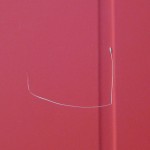A very detailed and informative post from The Preventive Vet
An Overview of Summer Pet Safety
Jason Nicholas – Wednesday, June 20, 2012
Summer is officially here! And who amongst you isn’t ready for the sunshine, BBQs, fireworks, trips to the river/lake/beach, and all the other joys that this time of year brings? Believe it or not, there is one group that likely isn’t ready… your pets!
With a few simple steps you can help prepare them and keep them safe this summer. This post will serve as an overview of the summer hazards that commonly sicken, injure, and kill cats and dogs this time of year. Awareness is such an important part of prevention. So please, give this post a read and be sure to share it with your pet-loving friends, family, neighbors, and co-workers. Here’s to a safe and wonderful summer for all – human and pet, alike!

Heat
Though that beautiful glowing orb in the sky improves our collective mood and helps to sustain life on our planet, it can lead to a few significant problems for our beloved pets, too.
Heat Stroke
This is a debilitating, devastating, distressing, and frequently fatal emergency condition that is often 100% preventable. Our pets just aren’t as adept at dealing with heat as we are, and cats and dogs everywhere will be put at unintentional risk until everyone is aware of this fact. For more information on this horrible and easily preventable condition – including what it is, which pets it most often affects, how to recognize and treat it, and (most importantly) how to prevent it – click here.
Paw Pad Burns
Ever walked barefoot on hot asphalt or sand? Hurts, doesn’t it? Though our cats and dogs have thicker paw pads that we have soles, they are still susceptible to pain and damage from walking on hot surfaces. Pets have suffered painful burns from spending too much time on hot asphalt, sand, or other surfaces. Keep this in mind when deciding whether or not to take your dog with you for a day at the local street fair or for a trip to the beach. If they’re likely to be spending a lot of time on such surfaces, consider outfitting them with a pair of dog booties or leaving them at home.
Sunburn and Skin Cancer
Just like us, our cats and dogs are susceptible to developing sunburn and skin cancer. Their most vulnerable areas are typically the top of their muzzle (nose), flaps of their ears, and the underside of their belly (for those who like to sunbathe on their back). Pets with lighter colored coats and those with minimal fur covering are at even higher risk. To minimize their risk consider keeping them indoors during the hottest parts of the day and using pet-safe sunscreen on those who must be out. *This is one case where it is relatively safe to assume that that which is safe for your baby is also safe for your pets – baby sunscreens are indeed safe to be used (in moderation) on your pets.

Water
More of us are likely to be spending time by the water this summer and that means that our dogs are likely to be doing so, too. Be aware though that even those dogs that are considered “strong swimmers” can have problems around the water.
Drowning and Near-Drowning
Depending on the composition of the water inhaled – salt vs. fresh vs. chlorinated – even a relatively small amount of aspirated water can cause significant problems for your pooch. Be aware of this both around your back yard pool and when at the beach/lake/river. Some important tips to follow include:
- Watch your dogs closely when they’re swimming – be sure to take them out before they become exhausted
- Never let dogs swim unobserved with a young child – either can quickly and unintentionally cause the drowning of the other
- Use lifejackets/PFDs on all dogs, including strong swimmers and those spending time on a boat, kayak, or stand-up paddleboard
- Be aware of and avoid rip currents at the beach and strong currents and strainers when at the river
- Outfit your backyard pool with a secure fence, water surface alarm, and a dog ramp
Blue-Green Algae and other Harmful Algal Blooms

Common on lakes and ponds, sun-loving algae tend to proliferate in the hot summer months. Certain types of algae produce toxins that can easily sicken, or even kill your dog. Check your state’s department of health website for algal bloom advisories and learn to recognize what these overgrowths look like.
Here’s a great picture of a blue-green algal bloom by Flickr user Neil Saunders.
Toxins

Slug and Snail Baits
If you live in a damp or low-lying part of the country, your pets are at risk of toxicity from slug and snail baits – even if you don’t use them in your own garden. Most of these baits contain the active ingredient Metaldehyde, a highly toxic compound that leads to neuromuscular dysfunction in the pet unfortunate enough to eat it. And eat it they do! Many pets are affected by metaldehyde toxicity each year, likely a result of the fact that many of these products are formulated with molasses to bind them and make them more attractive to the snails and slugs they are designed to kill. Keep your pets inside, on leashes, and out of the garden. Use non-chemical means of preventing or eradicating snails and slugs when possible, and use the safer iron-phosphate containing baits when chemical means are necessary.
Flea Treatments and Preventatives
Fleas are nasty little buggers and you should do all that you can to keep them off your pets and out of your home. That said, every summer, pet emergency rooms across the country fill up with cats suffering from pyrethrin toxicity when inappropriate products or excessive doses are applied. For safe and effective flea control talk to your veterinarian and see our in-depth flea blog post.
Antifreeze
Many people don’t think of antifreeze as a common summer pet hazard, but given that it’s in our cars year around (helping to keep the engine cool in the summer), it certainly is. The concerning ingredient in antifreeze/coolant is a compound called ethylene glycol. Even a small amount of ethylene glycol can destroy your pet’s kidneys, leading to kidney failure and death if not detected and treated in a timely fashion. Be sure to clean up all spills promptly and store these containers safely. Even with those steps though, the safest things you can do for your pets is to keep them indoors, keep them on a leash, and use a safer propylene glycol based alternative instead.
Injuries
Hit-By-Car
With more cats and dogs running around outside during the summer months it’s no wonder that cases of hit-by-car trauma go up this time of year. Be sure to check your yard fences and keep your dogs on leash and cats indoors.

High-Rise Syndrome
Don’t let your cat (or dog) be one of the unfortunate pets to fall from a balcony or open window this summer. Learn about this common summertime emergency and take the simple steps to prevent it. Recognize that, contrary to its name, you and your pets need not live in a skyscraper for them to be in danger. Read more about High-Rise Syndrome in pets here.
Dog Fights & Cat Bites
Regardless of whether they are inflicted at the local dog park or out around your neighborhood, animal bite wounds aren’t only painful; they transmit disease and often require veterinary treatment, too. Don’t be fooled by bites that look like “nothing”, either. Many a dog and cat has wound up in the ICU and/or requiring surgery from bite wounds that seemed innocuous… it’s the infections that brew and smolder beneath the surface of the skin and in the chest or abdominal cavity that can cause the most unexpected damage. Always have bite wounds evaluated by your veterinarian.

Fireworks
Not only do fireworks cause direct injuries to unfortunate pets, each year they also cause countless pets to run away and get hit by cars. Pets should be nowhere near fireworks displays and should always be kept securely indoors when such festivities are expected. Talk to your veterinarian early if sedation is likely to be needed and look into the Thundershirt if your pets are particularly stressed by such loud noises. Lastly, don’t forget about the importance of microchips in reuniting families with their lost pets – have it done and make sure to keep your contact information up-to-date.
Yard Equipment
Given the potential for direct injury (from lawnmower blades and edging strings) and for indirect injury (from kicked-up sticks, rocks, and other debris), it’s best to leave your pets safely indoors when doing work around the yard.

BBQ Food and ScrapsIf your pet gets into (or is given) scraps from the grill he’s likely to wind up with digestive upset or obstruction that may ruin your carpet and land him in the hospital. Meat scraps, corncobs, bones, and skewers are all common causes of digestive problems in pets this time of year. Best to leave your pooch inside during the festivities and make sure all is well cleaned up before letting him back out in the yard.
With a little bit of awareness and some easy preventive steps, you and your pet can enjoy a fun and safe summer together. Have a great summer everybody and stay safe!






Leave a Reply